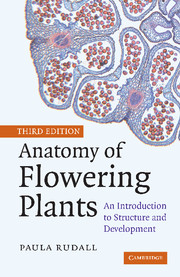2 - Stem
Published online by Cambridge University Press: 02 December 2010
Summary
Shoot Apex
The vegetative shoot apex contributes to extension growth of the shoot and initiates leaf primordia. Most shoot apices are indeterminate, though some (e.g. shoot thorns) become determinate. The vegetative shoot apical meristem is typically dome-shaped and partitioned by distinct zones of activity (Fig. 2.1). In many species, the outermost two (sometimes more) cell layers (L1 and L2, collectively termed the tunica) are maintained predominantly by anticlinal cell divisions. The corpus (L3), in which cell divisions are randomly oriented, is the region proximal to the tunica. Thus, the outer layers contribute to surface growth and the inner layers to an increase in volume, though there is often slight intergradation between the two layers.
The central regions of both tunica and corpus are sometimes larger and more highly vacuolated than those on either side. The central region underlying the corpus layer is a rib meristem; this gives rise to files of cells that later become the pith. This central region is surrounded by a peripheral flank meristem that produces the procambium, cortical region and leaf primordia.
Reproductive shoot apices are complex examples of determinate growth. During the transition to the flowering phase (termed floral transition), the shoot apex commonly undergoes profound morphological change, though the tunica/corpus structure is maintained. In general, at floral transition there is an overall increase in mitotic activity at the shoot apex, but a proportionally greater increase among the axial apical cells than among the peripheral cells.
- Type
- Chapter
- Information
- Anatomy of Flowering PlantsAn Introduction to Structure and Development, pp. 23 - 42Publisher: Cambridge University PressPrint publication year: 2007



